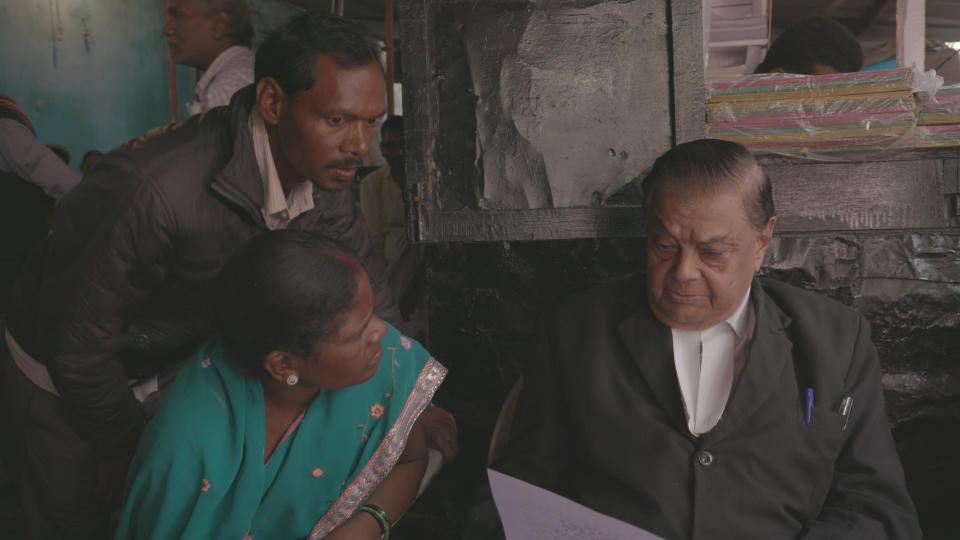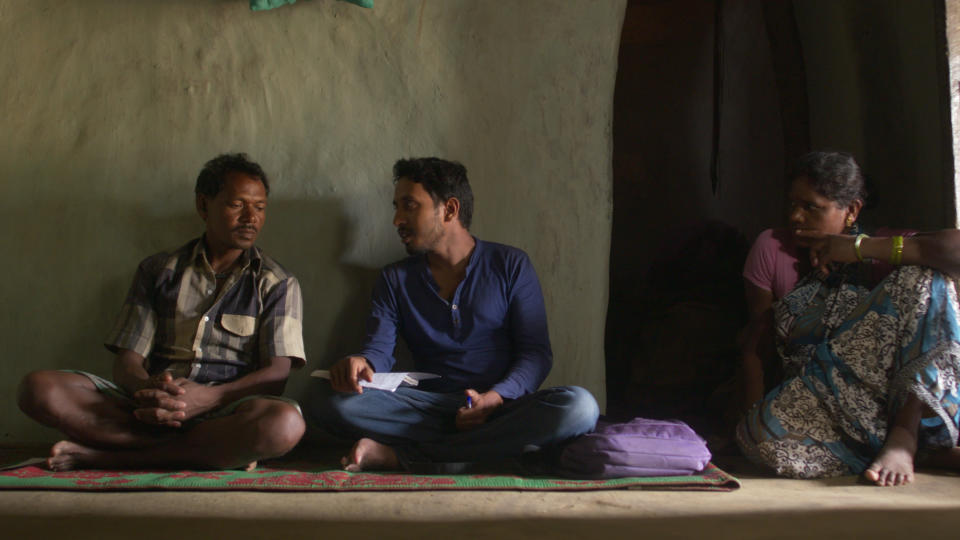Director Nisha Pahuja’s ‘To Kill A Tiger’ Follows An Indian Family’s Tenacious Fight For Justice After A Violent Sexual Assault; Dev Patel Joins Project As Its “Hype Man”
- Oops!Something went wrong.Please try again later.
- Oops!Something went wrong.Please try again later.
- Oops!Something went wrong.Please try again later.
- Oops!Something went wrong.Please try again later.

In a village in the Indian state of Jharkhand, Ranjit and his wife Jiganti keep vigil at night over their home, a simple dwelling with packed-earth floors. If they don’t, anything could happen: Their neighbors have threatened to kill the couple and their children.
Ranjit and Jiganti have done nothing to warrant such terror, other than to go against village customs. After their 13-year-old daughter Kiran was sexually assaulted by three local youths, they resisted intense pressure to remain silent — to excuse the crime and the perpetrators. Instead, they demanded justice.
More from Deadline
Their struggle plays out in the documentary To Kill a Tiger, directed by Nisha Pahuja and executive produced by a prominent team including Dev Patel, Mindy Kaling, poet Rupi Kaur, and Dr. Atul Gawande, the surgeon and bestselling author. The film, winner of more than 20 awards at festivals around the world, situates the story in an alarming cultural context: By one estimate, 71 percent of rapes in India go unreported.
Those who dare to speak out, like Kiran and her parents, risk a scornful backlash. As the film documents, Ranjit’s attempt to gain assistance from local officials met with hostility. “If the girl wasn’t there, would this have happened?” the local ward leader demands of him. “This is a major thing we should focus on… A girl always bears some blame.”

Pahuja, who was born in India but raised in Canada, spent eight years working on the film. Over that time, she gained a sense of the dynamics in a tiny, rural enclave like Bero.
“You’re understanding the intricacies of what this village is, the fact that it is kind of an ecosystem, a very complex ecosystem that is rooted in survival… India is a culture that is not based necessarily on the individual. It emphasizes community.”
What the community wanted soon became clear. They demanded Kiran’s parents marry the girl to one of her three assailants. “Marriage is the only solution,” one village woman insists. “Her house has been shamed by that boy, so how can having him marry her be a bad thing? She can’t marry another man now. She has to marry him.”
Ranjit and Jiganti, refusing to go along, are ostracized. “We are alone,” Jiganti says. “They raped my daughter,” Ranjit says forlornly, “but they shamed me.”
Authorities took Kiran’s alleged attackers into custody. But whether the case would move forward depended largely on Ranjit’s willingness to press ahead. Pahuja says it was painful to watch Ranjit, a low-caste man, try to navigate India’s legal system. She winces as she recalls “seeing Ranjit humiliated at court, the way he was dismissed, the way he was mistreated by the public prosecutor at times. We didn’t put it in the film, but there was a scene where they went in to get a new court date and they had to pay a bribe just for the guy to do their paperwork. And it was that kind of relentless humiliation that Ranjit was subjected to that was very difficult to witness.”
Scenes like those resonated for Patel, the star of Slumdog Millionaire who was born in England to parents of Indian descent. “It really is a David and Goliath story. Everything is stacked against this father and his daughter,” he says, “and I think it speaks a lot to the system in India which is so overloaded. There’s corruption. Any attempt at justice can feel impossible for someone in that status in society. So, you really are sitting at the edge of your seat wondering if this man is going to ever achieve any justice.”
Patel agreed to come on board as an EP after watching a cut of the film. “I had a visceral reaction to it, a very physical reaction,” he recalls, noting that he immediately contacted Pahuja to discuss it. “We had a phone conversation that went on for over an hour, and I was deeply moved and in awe of what she’d achieved for this.”

The actor says the story told in To Kill a Tiger hit him on a personal level. “I’ve spent most of my career traveling, living, filming and exploring in India, and it’s hard to ignore the cases of sexual violence against women and minors that flood the papers every day,” he says. “Many of the friends that I’ve made there have been exposed to some form of predatory behavior. I lost a friend called Monica who was raped and murdered, and to see such potential extinguished — Monica, to me, represented a kind of modern, new India… It really is an issue of huge proportions in India and globally.”
It’s not an accident that bold face names like Patel and Kaling became attached to the documentary. “I’ve known for over a year that if this film was going to get out into the world, it would need the support of celebrities, people like Mindy and Dev… because it’s a tough subject. It’s a hard subject,” Pahuja says. “It’s about a survivor who’s 13 years old. It’s a Canadian film, but it’s an Indian story, and it’s subtitled. But I think it’s just so important.”
“Part of me wanting to get behind the movie,” Patel says, “is we had this sort of stigma with Slumdog when the film got dropped by a major studio [Warner Bros.]. I guess to the naked eye, it looks like something that’s going to be not cinematic. It looks like something that’s going to be a real drag to get through. Poor Indian villagers out in the dusty center of some village in India — it’s hard to get an audience to sit for, but once people get in front of this film, it will grip you and the filmmaking and the story speaks for itself really. So, my mission has been getting behind Nisha and trying to get as many people to watch it. And stories like these need male advocates as much as they need female advocates too.”
Drama builds throughout To Kill a Tiger, as Ranjit appears on the edge of losing his nerve. He begins to drink more and misses a few critical court dates.
“There were lots of times where I thought, I don’t know if he’s going to be able to make it. As you see, there’s just so much pressure on him and it’s perpetual and the tenor of it keeps rising,” Pahuja says. “What was so interesting about it is that when Ranjit was in the dumps, mom was kind of bolstering his courage, or Kiran was… They were so unified as a family. They were kind of marching together and really determined to see it through.”
As Kiran prepared to give testimony in the trial of her alleged attackers, tensions in the village reached a boiling point. Villagers descended on the family home, directing their ire at the film crew. They threatened to set fire to the house and immolate everyone inside.
“I felt fear for the crew. I felt fear for the family. But I think the overriding emotion was one of shame… shame at [the situation] I had created,” Pahuja says, explaining that by pursuing the documentary project she felt she had exposed Ranjit and his family and the film team to danger. “I felt very responsible.”
Ethical quandaries arose throughout the shoot, Pahuja says, noting that she checked in regularly with Ranjit to make sure he was going after justice for his daughter’s sake and not for the filmmakers’. Perhaps the biggest dilemma for Pahuja was how to depict Kiran on screen.
“We tried many different things,” Panhuja says. “We worked with a couple of animators to come up with something.” After abandoning animation, they considered adopting an approach similar to the documentary Welcome to Chechnya, where a “facial replacement technique” was used to superimpose the face of a double over the true protagonist, whose life was in danger.
“We found an actress, a really lovely Tamil actress in Toronto who was willing to be the face of Kiran,” Pahuja explains. “And we did those tests and that was really interesting. But at the same time, we were having these audience screenings, and what was so clear was [the response] of, ‘Please don’t hide her… Let her humanity and who she is shine through.’ And so I just started this conversation with the family, and Kiran very intelligently said, ‘Let me see the film, and I’ll tell you what I think.’”
Kiran, who is now almost 20, gave her blessing to use undisguised footage of her in the film. The only concession to protecting her identity is her name; Kiran is a pseudonym.
“She saw the film and said, ‘‘No need to hide me. Absolutely. I don’t want to be hidden,’” Pahuja says. “I asked her why she decided to come forward. And she said it was because she couldn’t believe the courage she had at that age. And she felt if she could come forward at the age of 13, if she could stand up and fight for justice, then surely other people could also come forward… It is so courageous.”
Pahuja is working on an impact campaign around the film in collaboration with Equality Now, an NGO that promotes human rights for women and girls. “One goal is to create a fund for survivors who are seeking justice, so they don’t have to suffer the way [Ranjit’s] family did,” Pahuja says. “A second is to create, especially in India, a coalition of survivors, encouraging people who’ve experienced sexual violence to come forward and to stand together so that they’re not alone. The stigma that survivors of sexual violence experience is global. It’s universal. In India, there’s something kind of pathological about it… Stepping out of those shadows of shame that are imposed upon you is really important.”
Another focus of the campaign is “to really start this conversation on masculinity and understanding that it’s something that is a prison for all of us, because that’s what constructs are, right? Just by their very nature, they impose something on you. They tell you what you should be. And as men, there’s this feeling that there’s a tremendous power — and there is on the one hand, but it comes at a cost. It comes at a price, and we all pay the price for it. So, it’s getting all of us to see that.”
Patel says he’s trying to enlist more prominent people to support the film and what it stands for.
“I’m kind of here as the hype man,” he says, “and we’re hoping to get some courageous Indian stars to join us on this so we can affect the everyman out there too. And that’s the goal with this. I know success for this documentary globally will really start to turn heads in India and it will help change policy. And that’s great. That’s a step in the right direction.”
Best of Deadline
2023 Premiere Dates For New & Returning Series On Broadcast, Cable & Streaming
2023-24 Awards Season Calendar - Dates For Oscars, Emmys, Grammys, Tonys, Guilds & More
Sign up for Deadline's Newsletter. For the latest news, follow us on Facebook, Twitter, and Instagram.

